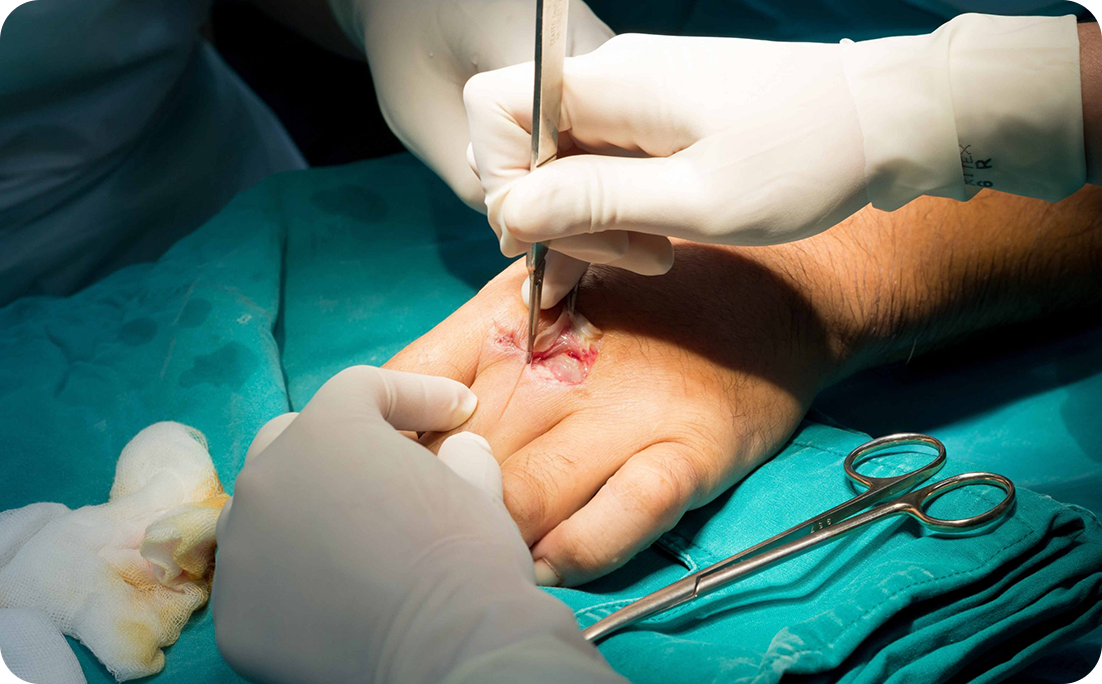What is bone tumor reconstructive surgery for Hand?
Bone tumor reconstructive surgery is a specialized medical procedure aimed at removing bone tumors in the hand while preserving or restoring the function and appearance of the hand. The primary goal of this surgery is to eradicate the tumor, prevent its recurrence, and maintain or enhance the hand's functionality.
The surgical procedure typically involves removing the tumor along with some healthy tissue surrounding it to ensure complete removal. The gap left in the bone is then filled with a bone graft taken from another part of the patient's body or a synthetic bone substitute. The surgeon may also use metal plates, screws, or rods to stabilize the hand and aid healing.
Types of Reconstructive Surgery Used for Bone Tumors
There are several types of reconstructive surgeries used for bone tumors, and the choice depends on factors like the tumor's size, location, and type, as well as the patient's overall health.
- Curettage: This is a minimally invasive procedure where the surgeon scrapes out the tumor from the bone. It's often used for benign tumors, followed by packing the cavity with bone graft or bone cement.
- Wide Resection: In this procedure, the surgeon removes the entire tumor along with a margin of healthy tissue. This is often used for malignant tumors to prevent their recurrence.
- Limb-Sparing Surgery: In cases where amputation might seem imminent, limb-sparing surgery can be an option. The surgeon removes the tumor and reconstructs the hand using a combination of techniques, including bone grafting and prosthetics
Timeline for Recovery and Rehabilitation
The timeline for recovery and rehabilitation depends on the type of surgery, your overall health, and how well you follow your post-operative care instructions. Some patients may recover within a few weeks, while others may take several months.
Physical therapy is often a critical part of the rehabilitation process, helping restore strength, flexibility, and function to the hand. Your specialist will provide you with a detailed recovery timeline based on your specific circumstances.
In conclusion, preparing for surgery, understanding the procedure, and following post-operative care instructions are essential for a successful outcome. With proper care and patience, most patients can expect to return to their normal activities and enjoy improved hand function after surgery.
Benefits of Bone Tumors Reconstructive Surgery for the Hand
Bone tumor reconstructive surgery offers several significant benefits. Firstly, it effectively removes the tumor and reduces the likelihood of recurrence. This is crucial in both improving the patient's prognosis and increasing survival rates.
Secondly, reconstructive surgery aims to preserve function in the hand. Techniques such as limb-sparing surgery, where the surgeon removes the tumor and replaces the bone with a prosthesis, can maintain or even enhance mobility and functionality.
Another advantage is that the reconstruction uses materials with biological affinity and resistance, leading to the regeneration of living bone of sufficient strength and durability.
Finally, in cases where amputation might seem imminent, reconstructive surgery can often spare the limb, thus significantly improving the patient's quality of life.
Frequently Asked Questions About Bone Tumor Reconstructive Surgery
The success of bone tumor reconstructive surgery depends on several factors, including the type, size, and location of the tumor, the patient's overall health, and the surgeon's expertise. In general, the procedure is highly effective in removing the tumor and preserving function, with many patients able to return to their normal activities.
Like all surgical procedures, bone tumor reconstructive surgery carries some risks. These can include infection, complications from anesthesia, poor wound healing, and the potential failure of the graft or prosthesis. There is also a chance of the cancer recurring.
While every effort is made to preserve function during surgery, some changes in hand function may occur. Most patients regain good function in their hands, although it may not be quite as strong or flexible as before. Physical therapy can help improve function over time.
Most insurance plans cover necessary medical procedures like bone tumor reconstructive surgery. However, the exact amount covered can vary depending on your specific plan. It's important to check with your insurance provider to understand what is covered.
After surgery, maintaining a healthy lifestyle can help support recovery and overall hand health. This includes eating a balanced diet, exercising regularly, avoiding smoking (which can impair circulation and slow healing), and following any specific guidelines provided by your specialist.
Case Study By

Dr Nishant Soni
(MBBS, MS-Ortho)
Experience
Hand & Reconstructive
Micro Surgeon with 13 yrs
as specialist
Work in Stats till 2023
5000+ Carpal Tunnel Surgery
10010+ Hand Fractures
3000+ Wrist Surgeries
40000+ Happy Patients
Associations
Medanta MedCity
SCI International Hospital
Medanta MedCity
SCI International Hospital
Read More


